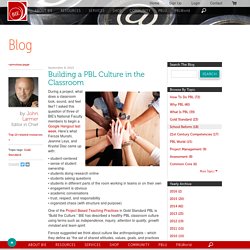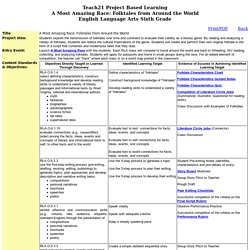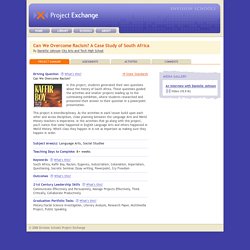

Getting Started with Project-Based Learning (Hint: Don't Go Crazy) Before the start of the school year, many of us want to use the remaining weeks of summer to learn some new skills -- such as project-based learning (PBL).

One of the things we stress for new PBL practitioners is, as I say, "don't go crazy. " It's easy to go "too big" when you first start PBL. I have heard from many teachers new to PBL that a large, eight-week integrated project was a mistake. So how do you start PBL in ways that will ensure your success as a learner and teacher?
Here are a few tips to consider. Start Small As I said, "Don't go crazy! " Plan Now One of the challenges of PBL, but also one of the joys, is the planning process. Limited Technology We love technology, but sometimes we get too "tech happy. " Know the Difference Between PBL and Projects This is the big one! We are all learners, and when we start something new, we start small. Photo credit: wwworks via Flickr (CC BY 2.0) Resources and Tools for PBL Start to Finish. Tips for downloading: PDF files can be viewed on a wide variety of platforms -- both as a browser plug-in or a stand-alone application -- with Adobe's free Acrobat Reader program.

Click here to download the latest version of Adobe Reader. Documents to Help You Get Started The Hunger Games Project Documents Below are sample project-based learning documents from teachers Mary Mobley (English) and Michael Chambers (world history) of Manor New Technology High School in Manor, Texas. They team-teach a sophomore world studies class. The Design Thinking School \ What we do. Design Thinking can be a powerful vehicle for deeper learning of content, more divergent thinking and building the thinking skills capacity of learners.

Key to the process's success in learning, is that it provides the platform for learners to become problem finders. At a time when design thinking tends to come across as "shop" class and post-it notes, NoTosh have spent four years developing medium- and long-term professional development programmes with schools around the world, which marry design and education research with classroom practices that work in any part of curriculum. Driving Questions. Driving Questions. Building a PBL Culture in the Classroom. During a project, what does a classroom look, sound, and feel like?

I asked this question of three of BIE’s National Faculty members to begin a Google Hangout last week. Here’s what Feroze Munshi, Jeanine Leys, and Krystal Diaz came up with: • student-centered • sense of student ownership • students doing research online • students asking questions • students in different parts of the room working in teams or on their own • engagement is obvious • academic conversations • trust, respect, and responsibility • organized chaos (with structure and purpose) One of the Project Based Teaching Practices in Gold Standard PBL is “Build the Culture.”
BIE has described a healthy PBL classroom culture using terms such as independence, inquiry, attention to quality, growth mindset and team spirit. Let’s consider what a culture of independence is like. It's important to build student independence; you can’t just turn them loose and expect them to be able to effectively function autonomously.
Educational Leadership:Giving Students Meaningful Work:Seven Essentials for Project-Based Learning. Complete Guide to Project-Based Learning. Modern science continues to develop in such a way that the older generation is constantly trying to catch up with the younger generation’s adaptation to new developments and technologies.

It is only logical that we should utilize our students’ familiarity with technology from a young age to maximize their engagement and learning by integrating it into our curriculum. Sample Project: Healthy Choices = Long Life! Teach21 Project Based Learning. This PBL should be considered as having two different parts.

First, the students must gather the information needed to complete the problem. Second, the students must compile their data to create an original script based on a set of criteria. Breaking down this long-term project seems to make it more manageable for the teacher. Like scientists, the students must gather information, analyze it, and produce a product. Part I of the PBL involves the race. Part II of the PBL focuses on the problem. Students should be grouped in Part I of the PBL. Envision Schools Project Exchange. In this project, students generated their own questions about the history of South Africa.

These questions guided the activities and smaller projects leading up to the culminating exhibition, where students researched and presented their answer to their question in a powerpoint presentation. This project is interdisciplinary. As the activities in each lesson build upon each other and across disciplines, close planning between the Language Arts and World History teachers is imperative. In the activities that go along with this project, you'll notice that some happened in English Language Arts and others happened in World History. Which class they happen in is not as important as making sure they happen in order. Subject Area(s): Language Arts, Social Studies Teaching Days to Complete: 8+ weeks South Africa, Kaffir Boy, Racism, Eugenics, Industrialism, Colonialism, Imperialism, Questioning, Socratic Seminar, Essay writing, Powerpoint, Cry Freedom Can We Overcome Racism?
Student Handouts. Books. Building a PBL Culture in the Classroom.